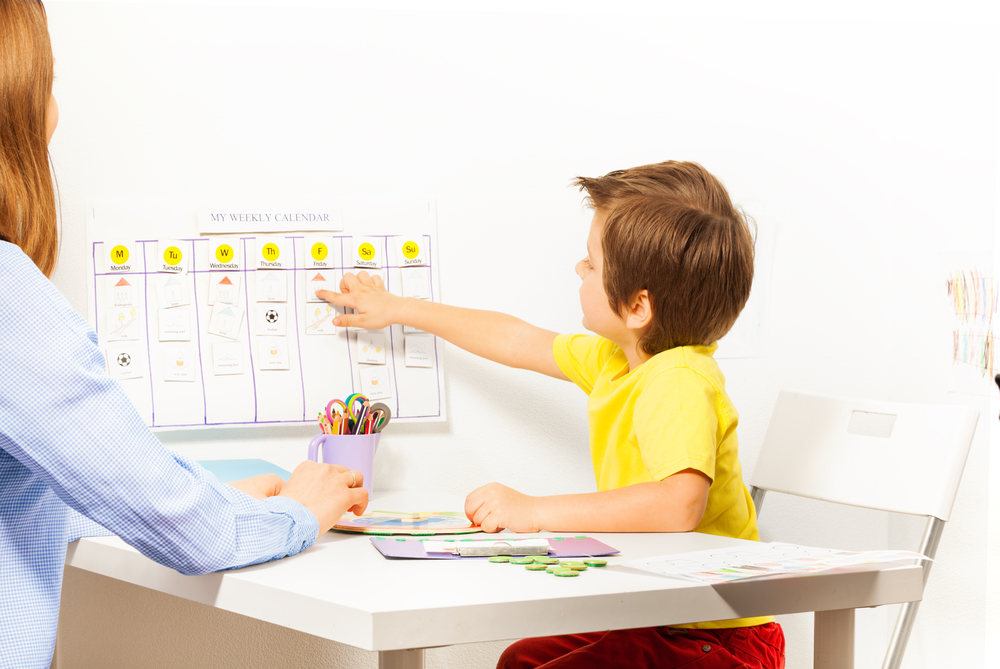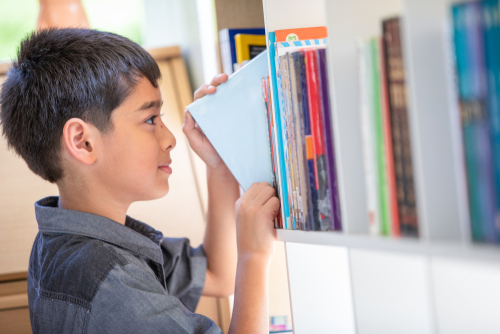
Visual scheduling is a systematic technique that enhances learning and communication for individuals with autism spectrum disorder (ASD). These types of visual supports provide teachers and parents with the tools needed to help children reach development goals and achieve success in life.
What is a Visual Schedule?

A visual schedule is a graphic representation of scheduled tasks and activities. They are very useful for breaking down tasks that have multiple steps and ensuring that children follow rules and deadlines. Visual schedules reduce anxiety by providing consistency while also reducing resistance that comes with certain activities. Although most people associate these visual supports with picture schedules or photographs, events can be triggered through:
- toys
- objects
- word phrases
The visual schedule itself is a constant reminder to students of:
Featured Programs
- where they should be
- what they should be doing and
- when they should start and finish
How to Implement Visual Schedules for Students with Autism

There are some important considerations when implementing visual schedules for autism:
To be effective, teachers and parents should first ensure that the child understands the concept of sequenced activities. Visual schedules are often taught through:
- pictures
- photos
- role play
The schedule needs to be manageable. When autistic children are overwhelmed by the sequence of events they may give up. You want to teach them how to be successful and independent not overly frustrated. When you see a child struggling, you can break the picture schedule up into chunks to make it easier to follow.
Most educators prefer to mix preferred activities with non-preferred ones. This helps to motivate children to persevere through non-preferred activities. For example, a good primary intervention is a first-then board. Students with autism are taught that they will be able to do an activity they enjoy if they first perform a behavior that they don’t like as much.
Personalize the visual scheduler. The more autistic children can relate to the visual supports, the more likely that they will understand them. For example, including photos of the individual student successfully completing the steps of the process will facilitate learning and improve self-efficacy.
Physical reminders are usually posted on walls, but they can also be portable through a binder or clipboard. Regardless of the locations, the child should be able to see these visual supports to stay on track during the day.
When it is time for a scheduled activity to occur, children are cued with a brief verbal reminder and if necessary, physically guided to the posted visual or picture schedule.
Prompts are given when necessary. Either a verbal or non-verbal prompt can be provided if the student does not respond to the initial cue. Ideally, prompts are phased out as the student learns.
Everyone likes to cross items off their list. It is important to give students a way to show that they have successfully completed an activity. For example, include a “done” checkbox at the end of each step. It will provide a sense of accomplishment and reinforce their efforts.
Speaking of reinforcement, visual schedules need to be accompanied by some form of reward, especially when a student can complete a task independently. This can take the form of verbal praise, a treat, or a fun activity.
Using Visual Supports to Deal with Challenging Behaviors

There will inevitably be resistance against maintaining the schedule. When challenging behaviors occur, teachers focus on completing the task at hand. If the difficult behaviors continue, teachers may rearrange the schedule with a preferred activity as the reward for task completion.
For important tasks that will create challenges, teachers often give a visual schedule reminder during a preferred task. Praise and positive reinforcement for following these picture schedules, completing tasks and successfully transitioning to other activities are very helpful. Some teachers find it is helpful to use a timer to help children stay focused and transition to new tasks.
How Teachers Organize Visual Schedules

When it comes to visual schedules autism, special education teachers creatively use everything from color coding to school bell synchronization. In order to maximize effectiveness, teachers individually organize visual schedules based on the learner’s preferences and personality. Every morning, the teacher will arrange the student’s daily routine and associated learning materials before the student’s arrival. This may require them to verify if objects are gathered in task baskets or in handy aprons that special education teachers wear. It may be appropriate to empower older students to control and enforce their own schedules. For developmentally delayed students of those with autism spectrum disorders, it may be appropriate to physically coach and guide students through the entire process when using visual supports.
Featured Programs
A Visual Schedule as an Applied Behavior Analysis Technique

A visual schedule can also be beneficial as an Applied Behavior Analysis (ABA) therapy technique. Since ABA is a popular and well-researched type of therapy for individuals with autism spectrum disorders, it makes sense that a visual schedule could be a part of that approach. A visual schedule can also be used to reinforce verbal instructions. An ABA visual schedule may follow a Picture Exchange Communication System (PECS). PECS was created in 1985 by Andy Bonday, PhD and Lori Frost, MS, CCC-SLP. It was implemented at the Delaware Autism Program with pre-school aged students on the autism spectrum. Since then, PECS has been used with many kids with diagnoses like:
- Down Syndrome
- Tourette Syndrome
- Asperger’s Syndrome
- Developmental disorders
PECS works in six phases. These include:
Phase I: How to Communicate
In Phase I, the individual learns that the pictures represent an item or activity they want. They learn to exchange the picture for the item or activity. They might exchange a picture of a deck of cards for an actual deck of cards.
Phase II: Distance and Persistence
Individuals still use a single picture and begin to generalize this with different people and places. They also learn how to be more persistent in their communication. Instead of just using the picture in a classroom, they may take their portable schedule with them to the park or out shopping.
Phase III: Picture Discrimination
As individuals get more comfortable exchanging a picture, they begin to use two or more pictures to initiate a request for their favorite items.
Phase IV: Sentence Structure
Students can learn to build sentences using PECS. They can build simple sentences using the pictures in their communication book. These books are designed with a detachable “Sentence Strip” which allows students to put join pictures in a row to make a sentence. They might use a picture with the written words “I want” followed by a picture of an activity or item they would like to have. Pictures are stored in the book so students can easily find the pictures they need to communicate with those around them. As students get more proficient with their communication skills, they can add adjectives and verbs to communicate more effectively.
Phase V: Responsive Requesting
In Phase V, the student uses their communication book to respond to a request. If you ask an individual what they would like to do during free time in the afternoon, they could construct a sentence letting their teacher know how they would like to spend that time.
Phase VI: Commenting
Finally, students begin to use their communication book to share their thoughts and feelings. They become more engaged with their peers and surroundings. Instead of simply asking for items, they begin to make sentences that indicate how they feel or what they see.
Benefits of Visual Schedules

There are several reasons why visual schedules are both popular and helpful:
-
Structure and Predictability
Visual schedules provide structured predictability. Students with autism or other developmental disabilities may need to know what is coming next so they can emotionally prepare for the upcoming activity. A picture schedule for autism presents the student with expectations that they can then manage, helping to ease transition periods. In general, the fewer surprises the better; unexpected events are usually unwelcome and may lead to acting out behavior. The predictability of a schedule provides visual support and a sense of security. It can also ease anxiety.
-
Increases Learning
These types of visual supports can be used to teach students a daily routine as well as skills to perform a specific activity. A visual schedule for autism classrooms can help students stay on track. For example, a teacher may post the day’s picture schedule on a wall or provide pictures that describe steps on how to go to the bathroom. Giving step-by-step visual cues appears to be an effective way for most autistic kids to learn and helps keep them on task. Visual schedules can be created for almost any set of skills, including:
- social interactions
- routines
- academics
- daily living
-
Turns Abstract Into Concrete
The processing of abstract principles is difficult for any person but is more so for the autistic child. Visual schedules help students understand abstract concepts including time and organization. Abstract ideas are transformed into tangible objects with these visual aids. Turning an abstract concept into something accessible and concrete is crucial to enhance understanding.
-
Independence
The ultimate goal when working with autistic children is independent functioning. The autism visual schedule provides an opportunity for students to learn with minimal outside intervention. Besides mastering specific skills, students acquire the ability to:
- organize
- make decisions
- employ time management
These are all crucial abilities for independence. Eventually, they may be able to create and follow their own schedules, indicating their progress toward being more self-sufficient.
ABA Programs Guide Staff
More Articles of Interest for Visual Schedule Autism: